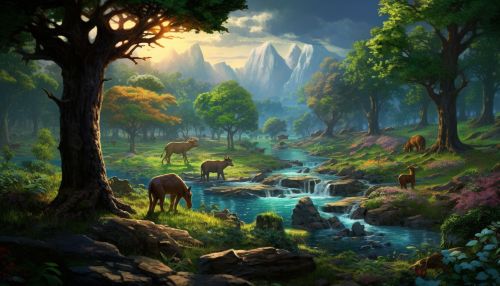Paleogene
Introduction
The Paleogene (also spelled Palaeogene) period is a unit of geologic time, extending from about 66 to 23 million years ago. It is the first of two periods in the Cenozoic Era, followed by the Neogene period. The Paleogene is significant for its dramatic changes in climate and geography, as well as the evolution and diversification of mammals and birds.


Geology
The Paleogene period is marked by significant geological events, including the continued break-up of the supercontinent Pangaea, the formation of the modern continents, and the creation of many of the earth's major mountain ranges. The period also saw the development of the first ice caps in Antarctica, marking a shift towards a cooler global climate.
Continental Drift
The Paleogene period witnessed the continuation of the continental drift that began in the Mesozoic Era. The supercontinent Pangaea, which had begun to break up in the Mesozoic, continued to fragment into the continents we know today. This process had profound effects on the climate, ocean circulation, and the distribution of plants and animals.
Mountain Building
The Paleogene period was a time of significant mountain building, or orogeny. This was particularly evident in the formation of the Alps, the Rocky Mountains, and the Himalayas. These mountain ranges were formed through the process of plate tectonics, as the earth's crustal plates collided and folded.
Climate Change
The Paleogene period was characterized by a long-term global cooling trend. This was largely due to the isolation of Antarctica and the formation of the Antarctic Circumpolar Current, which disrupted warm ocean currents and led to the formation of the first permanent ice caps at the South Pole.
Paleontology
The Paleogene period is notable for the diversification and evolution of mammals and birds. Following the Cretaceous–Paleogene extinction event, which marked the end of the Cretaceous period and the extinction of the dinosaurs, mammals and birds emerged as the dominant terrestrial vertebrates.
Mammals
The Paleogene period saw the rapid diversification and evolution of mammals. Early mammals were small, nocturnal creatures, but with the extinction of the dinosaurs, they began to fill the vacant ecological niches. This led to the evolution of a wide variety of mammalian forms, including the first primates, the group of mammals that includes humans.
Birds
The Paleogene period also saw the diversification of birds. With the extinction of the large, predatory dinosaurs, birds were able to evolve into a wide variety of forms and sizes. This period saw the emergence of the first large, flightless birds, as well as the first owls and perching birds.
